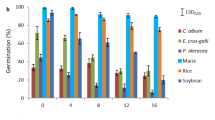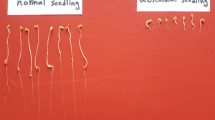Abstract
Laboratory/greenhouse and field experiments were conducted to evaluate the effects of salinity levels ranging from 1 to 12 dS/m on germination rate, 8 leaf seedling dry matter, seed yield, and seed oil content of the 8 Canola (Brassica napus) cultivars: ACSN1, Falcon, Shirali, Ceres, Tower, Cobra, Global, and Oyerka. Statistical results revealed that the factors: salinity, cultivar, and their interaction had significant (P<0.01) effect on germination rate and 8 leaf seedling dry matter. Based on statistical analysis seed yield was significantly influenced by both salinity and cultivar at the 5% significance level; while the cultivar factor had a significant effect on seed oil content, salinity did not show any effect on seed oil content. Analytical results, using the well-known sigmoid or S-shape salinity response function gave reliable results for determining tolerant and sensitive cultivars to salinity. Applying an existing model on canola response to salinity levels in different growth stages, the values of C 50 and P parameters were developed for local canola cultivars. Results showed that the response of cultivars to salinity levels vary in different growth stages. While a cultivar is tolerant in a growth stage, it may be sensitive to salinity in another growth stage. Based on observed data and ANOVA analysis, we concluded that ACSN1, Shiraly, and Falcon can be ranked as salt-tolerant, and Global and Oyerka as the salt-sensitive cultivars.








Similar content being viewed by others
References
Ashraf M, McNeilly T (1990) Responses of four Brassica species to sodium chloride. Environ Exp Bot 30:475–487
Beatty KD, Ehlig CF (1973) A technique for testing and selecting for salt tolerance in suger beet. J Am Soc Suger Beet Technol 17:295–299
Bernestein L, Hayward HE (1958) Physiology of salt tolerance. Annu Rev Plant Physiol 9:25–46
Corwin DL, Rhoades JD, Vaughan PJ (1996) GIS applications to the basin-scale assessment of soil salinity and salt loading to groundwater. SSSA Spec Publ 48:295–313
Dirksen C, Kool JB, Koorevaar P, Th. van Genuchten M (1993) HYSWASOR-simulation model of hysteretic water and solute transport in the root zone. In: Russo D, Dagan G (eds) Water flow and solute transport in soils. Springer, Berlin Heidelberg New York, pp 99–122
Epstein E, Norlyn JD, Rush DW, Kingsbury RW, Kelley DB, Cunningham GA (1980) Saline culture of crops: a genetic approach. Science 210:399–404
Ferguson L, Poss JA, Grattan SR, Grieve CM, Wang D, Wilson C, Donovan TJ, Chao CT (2002) Pistachio rootstocks influence Scion growth and ion relations under salinity and Boron stress. J Am Soc Hortic Sci 127:194–199
Feinerman E, Yaron D, Bielorai H (1982) Linear crop response functions to salinity with a threshold salinity level. Water Resour Res 18:101–106
Francois LE (1994a) Growth, seed yield and oil content of canola growth under saline conditions. Agron J 86:233–237
Francois LE (1994b) Yield and quality response of salt-stressed garlic. HortScience 29:1314–1317
Francois LE (1996) Salinity effects on four sunflower hybrids. Agron J 88:215–219
Francois LE, Kleiman R (1990) Salinity effects on vegetative growth, seed yield, and fatty acid composition of Crambe. Agron J 82:1110–1114
van Genuchten M Th (1987) A numerical model for water and solute movement in and below the root zone. Research report. US Salinity Laboratory, Riverside
van Genuchten M Th, Hoffman GJ (1984) Analysis of crop salt tolerance data. In: Shainberg I, Shalhevet J (eds) Soil salinity under irrigation- process and management. Springer, Berlin Heidelberg New York, pp 258–271
van Genuchten M Th, Gupta SK (1993) A reassessment of the crop tolerance response function. J Indian Soc Soil Sci 41:730–737
Ghassemi F, Jakeman AJ, Nik HA (1995) Salinisation of land and water resources. Human causes, extent, management and case studies. University of New South Wales Press, Sydney, pp 526
Grieve CM, Poss JA, Donovan TJ, Francois LE (1997) Salinity effects on growth, leaf-ion content and seed production of Lesquerella fendleri (Gray) S. Wats. Ind Crops Prod 7:69–76
He T, Cramer GR (1992) Growth and mineral nutrition of six rapid-cycling Brassica species in response to sea water salinity. Plant Soil 139:285–294
Homaee M (1999) Root water uptake under non-uniform transient salinity and water stress. PhD Dissertation, Wageningen Agricultural University
Homaee M, Dirksen C, Feddes RA (2002a) Simulation of root water uptake I. Non-uniform transient salinity using different macroscopic reduction functions. Agric Water Manage 57:89–109
Homaee M, Feddes RA, Dirksen C (2002b) A macroscopic water extraction model for nonuniform transient salinity and water stress. Soil Sci Soc Am J 66:1764–1772
Huang J, Redmann RE (1995) Physiological responses of canola and wild mustard to salinity and contrasting calcium supply. J Plant Nutr 18:1931–1949
Jones RA, Qualset CO (1984) Breeding crops for environmental stress tolerance. In: Collins GB, Petolino JG (eds) Applications of genetic engineering to crop improvement. Nijhoff/Junk, Dordrecht, pp 305–340
Kumar D (1990) Screening of related Brassica species for seedling emergence and seed yield under saline conditions. Seminar genetics of Brassicas. Rajasthan Agricultural University, Jaipur
Kumar V, Kumar D (1985) Effect of sodicity and seed rate on seed yield and oil content of Indian mustard. Curr Agric 9:21–26
Maliwal GL (1973) Tolerance of field crops to salts. Farmers Parliam 8:17–18
Mass EV, Hoffman GJ, Chaba GD, Poss JA, Shannon MC (1983) Salt sensitivity of corn at various growth stages. Irrigation Sci 7:1–11
Redmann RE, Qi MQ, Belyk M (1994) Growth of transgenetic and standard canola (B. napus) varieties to soil salinity. Can J Plant Sci 74:797–799
Richards RA (1983) Should selection for yield in saline regions be made on saline or non-saline soils? Euphytica 32:413–438
Richards RA (1995) Improving crop production on salt-affected soils: by breeding or management? Exp Agric 31:396–408
SAS Institute Inc. (1996) SAS/STAT user’s guide, Version 6.12, SAS Institute Inc., Cary
Sepaskhah AR, Ahmadi SH, Nikbakht Shahbazi AR (2005) Geostatistical analysis of sorptivity for a soil under tilled and no-tilled conditions. Soil Tillage Res 83:237–245
Shannon MC, Grieve CM (1999) Tolerance of vegetable crops to salinity. Sci Hortic 78:5–38
Shannon MC, Grieve CM, Lesch SM, Draper JH (2000) Analysis of salt tolerance in nine leafy vegetables irrigated with saline drainage water. J Am Soc Hortic Sci 125:658–664
Snedecor GW, Cochran WG (1967) Statistical methods, 6th edn. The Iowa State University Press, Iowa, p 593
Zeng L, Lesch SM, Grieve CM (2003) Rice growth and yield respond to changes in water depth and salinity stress. Agric Water Manage 59:67–75
Acknowledgment
The authors would like to appreciate Professor M. Th. van Genuchten (U.S. Department of Agriculture, Agricultural Research Service, George E. Brown Jr., Salinity Laboratory) for his constructive and useful comments on the first draft of the paper. Furthermore, the authors thank two anonymous reviewers whose comments and suggestions improved the quality of the paper.
Author information
Authors and Affiliations
Corresponding author
Additional information
Communicated by R. Evans
Rights and permissions
About this article
Cite this article
Ahmadi, S.H., Ardekani, J.N. The effect of water salinity on growth and physiological stages of eight Canola (Brassica napus) cultivars. Irrig Sci 25, 11–20 (2006). https://doi.org/10.1007/s00271-006-0030-3
Received:
Accepted:
Published:
Issue Date:
DOI: https://doi.org/10.1007/s00271-006-0030-3




